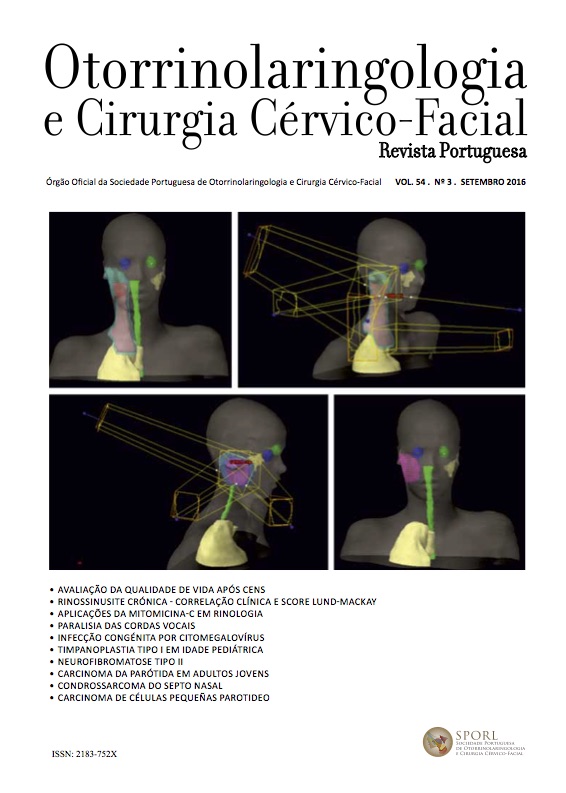Tympanoplasty type I in children - Our experience and factors affecting outcome
DOI:
https://doi.org/10.34631/sporl.567Keywords:
Timpanoplastia em criança, fatores preditivos, perfuração timpânica, taxa de sucessoAbstract
Objective: To analyze the success rate of tympanoplasty type I in children as well as the predictors of success.
Study Design: Retrospective analysis.
Methods: Review of 67 cases of children aged 6-18 years undergoing tympanoplasty type I in Centro Hospitalar e Universitário de Coimbra (CHUC) – pólo Hospital Pediátrico (HP) / Hospital Geral (HG) between January 2002 and April 2012, recorded the following variables: sex, age at surgery, etiology of the perforation, size and location of perforation, preoperative status of the contralateral ear, surgical history of operated and contralateral ear, history of prior adenoidectomy, season of surgery.
Results: anatomic success rate was 77.61% and audiological success 71.64%. Statistical evaluation showed that the state of the contralateral ear is an important predictor of success.
Conclusion: The study shows that timpanoplasty is a valid option in the treatment of perforated eardrum in children. The state of the contralateral ear factor seems to be a predictor of success.
Downloads
References
Isaacson, G. Tympanoplasty in Children. Otolaryngol. Clin. North Am. 1994; 27 (3):593-605.
Bluestone C, Cantenkin E, Douglas G. Eustachian tube function related to the results of tympanoplasty in children. Laryngoscope. 1979 Mar;89(3):450-8.
Knapik M, Saliba I. Pediatric myringoplasty: A study of factores affecting outcome. Int J Pediatr Otorhinolaryngol. 2011 Jun;75(6):818-23.
Lin AC, Messner AH. Pediatric Tympanoplasty: factors affecting sucess. Curr Opin Otolaryngol Head Neck Surg. 2008 Feb;16(1):64-8
Chandrasekhar SS, House JW, Devgan U. Pediatric Tympanoplasty: a 10 year experience. Arch Otolaryngol Head Neck Surg. 1995 Aug;121(8):873-8.
Denoyelle F, Roger H, Chauvin P, Grabedian EN. Myringoplasty in children: predictive factors of outcome. Laryngoscope. 1999
Jan;109(1):47-51.
Kessler A, Potsic W, Marsh R. Type 1 tympanoplasty in children. Arch Otolaryngol Head Neck Surg. 1994 May;120(5):487-90.
Raine C, Singh S. Tympanoplasty in children: a review of 114 cases. J Laryngol Otol. 1983 Mar;97(3):217-21.
Black J, Hickey S, Wormald P. An Analysis of the results of myringoplasry in children. Int J Pediatr Otorhinolaryngol. 1995
Jan;31(1):95-100.
Carr MM, Poje CP, Nagy ML, Pizzuto MP, et al. Sucess Rates in Paediatric Tympanoplasty. J Otolaryngol. 2001 Aug;30(4):199-202.
Caylan R, Titiz A, Falconi M, Donato G, et al. Myringoplasty in children: factors influencing surgical outcome. Otolaryngol Head Neck Surg. 1998 May;118(5):709-13.
Yung M, Neumann C, Vowler SL. A Longitudinal Study on Pediatric Myringoplasty. Otol Neurotol. 2007 Apr;28(3):353-5.
Vrabec JT, Deskin RW, Grady JJ. Meta-analusis of pediatric tympanoplasty. Arch Otolaryngol Head Neck Surg. 1999
May;125(5):530-4.
Koch, WM, Friedman EM, McGill TJ, Healy GB,. Tympanoplasty in children. The Boston Children's Hospital experience. Arch Otolaryngol Head Neck Surg. 1990 Jan;116(1):35-40.
James AL, Papsin BC. Ten top Considerations in Pediatric Tympanoplasty Otolaryngol Head Neck Surg. 2012 Dec;147(6):992-8.
Sheahan P, O'Dwyer T, Blayney A. Results of type 1 tympanoplasty in children and parental perceptions of outcome of surgery. J Laryngol Otol. 2002 Jun;116(6):430-4.
Société Française, d'Otorhinolaryngologie. Surgical Treatment of tympanic perforation in children. Arch.Pediatr. 2005; 12 (3) 372-76.
MacDonald RR, Lusk RP, Muntz HR. Fasciaform myringoplasty in children Arch Otolaryngol Head Neck Surg. 1994 Feb;120(2):138-43.
Saliba. Hyaluronic acid fat graft myringoplasty: how we do it. Clin Otolaryngol. 2008 Dec;33(6):610-4.
Lancaster JL, Makura ZG, Porter G, McCormick M. Paediatric tympanoplasty. J. Laryngol. Otol. 1999:113(7):628-32.
Lau T, Tos M. Tympanoplasty in children: an analysis of late results. Am J Otol. 1986 Jan;7(1):55-9.
Singh GB, Sidhu TS, Sharma A, Singh N. Tympanoplasty type 1 in children an evaluative study. Int J Pediatr Otorhinolaryngol. 2005 Aug;69(8):1071-6
Uyar Y, Keleş B, Koç S, Oztürk K, et al. Tympanoplasty in paediatric patients. Int J Pediatr Otorhinolaryngol. 2006 Oct;70(10):1805-9.
Ophir D, Porat M, Marshak G. Myringoplasty in pediatric population Arch Otolaryngol Head Neck Surg. 1987 Dec;113(12):1288-90.
Sckolnick JS, Mantle M, Li J, Chi DH. Paediatric Myringoplasty: Factors That Affect Sucess - A Retrospective Study. Laryngoscope. 2008 Apr;118(4):723-9.






